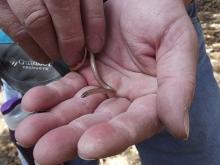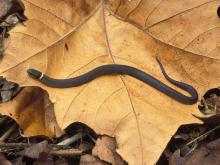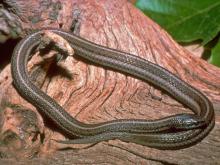Reptiles and Amphibians
Media

Species Types
Scientific Name
Coluber constrictor flaviventris (eastern yellow-bellied racer) and Coluber constrictor priapus (southern black racer)
Description
The eastern yellow-bellied racer is uniformly tan, brown, olive, blue, gray, or nearly black on top, with a yellow, cream, or light blue-gray belly. It occurs nearly statewide. The southern black racer subspecies also lives in the southeastern half of the state.
Media

Species Types
Scientific Name
Storeria occipitomaculata
Description
The red-bellied snake is one of Missouri's smallest snakes. It is gray or reddish brown on top, usually with narrow stripes, and bright red or orange below. It occurs nearly statewide but appears to be absent from the northwest and southwest corners.
Media

Species Types
Scientific Name
Tantilla gracilis
Description
The flat-headed snake is Missouri's smallest snake. It is found in the southern half of the state except the far southeastern corner.
Media

Species Types
Scientific Name
Haldea striatula (formerly Virginia striatula)
Description
The rough earthsnake is a small, plain-looking snake of open, rocky woodlands in the Missouri Ozarks. It normally doesn’t exceed 10 inches in length.
Media

Species Types
Scientific Name
Diadophis punctatus arnyi
Description
Prairie ring-necked snakes are easily recognizable by their small size, uniform dark color on the back, bright yellow-orange belly, and distinct yellow ring around the neck. Secretive, but common nearly statewide.
Media

Species Types
Scientific Name
Storeria dekayi
Description
Dekay's brownsnake is a small, secretive species that prefers moist environments. It can be gray to brown to reddish brown. It usually has a tan stripe running down the back, bordered by two rows of small brown spots. The top of the head is usually dark. Occurs statewide.
Media

Species Types
Scientific Name
Tropidoclonion lineatum
Description
The lined snake looks similar to a gartersnake. It is brown to grayish brown, with three lighter-colored stripes down the length of its body and a double row of half-moon-shaped markings along the belly. It occurs mainly in the northwestern part of the state, along the northern border, with a separate population in the St. Louis area.
Media

Species Types
Scientific Name
Lampropeltis calligaster
Description
The prairie kingsnake is fairly common over most of the state. The overall color is tan, brownish gray, or greenish gray. Numerous dark blotches down the back and sides are brown, reddish, or greenish brown. It lives in prairies, open woods, and rocky, wooded hillsides, statewide.
Media

Species Types
Scientific Name
Heterodon platirhinos
Description
The eastern hog-nosed snake is a nonvenomous snake that is highly variable in color and pattern. It has an upturned snout and can hiss loudly and spread its neck like a cobra. If this defense fails, the snake may thrash around, open its mouth, roll over, and play dead.
Media

Species Types
Scientific Name
Pantherophis emoryi
Description
The Great Plains ratsnake is seldom seen. It has numerous brown blotches along the body, a brown eye stripe, and a spearhead marking on top of the head.
See Also
About Reptiles and Amphibians in Missouri
Missouri’s herptiles comprise 43 amphibians and 75 reptiles. Amphibians, including salamanders, toads, and frogs, are vertebrate animals that spend at least part of their life cycle in water. They usually have moist skin, lack scales or claws, and are ectothermal (cold-blooded), so they do not produce their own body heat the way birds and mammals do. Reptiles, including turtles, lizards, and snakes, are also vertebrates, and most are ectothermal, but unlike amphibians, reptiles have dry skin with scales, the ones with legs have claws, and they do not have to live part of their lives in water.





















